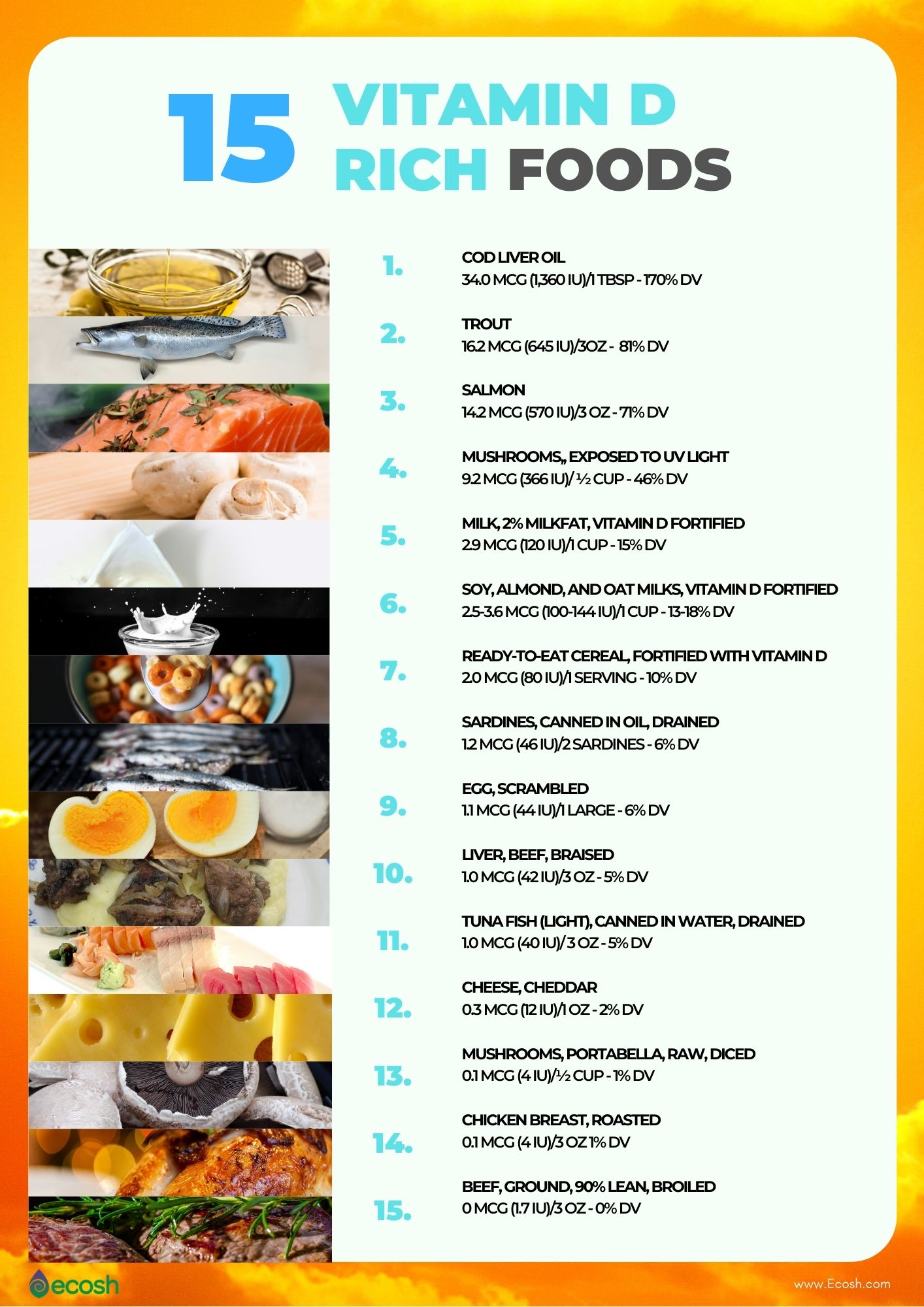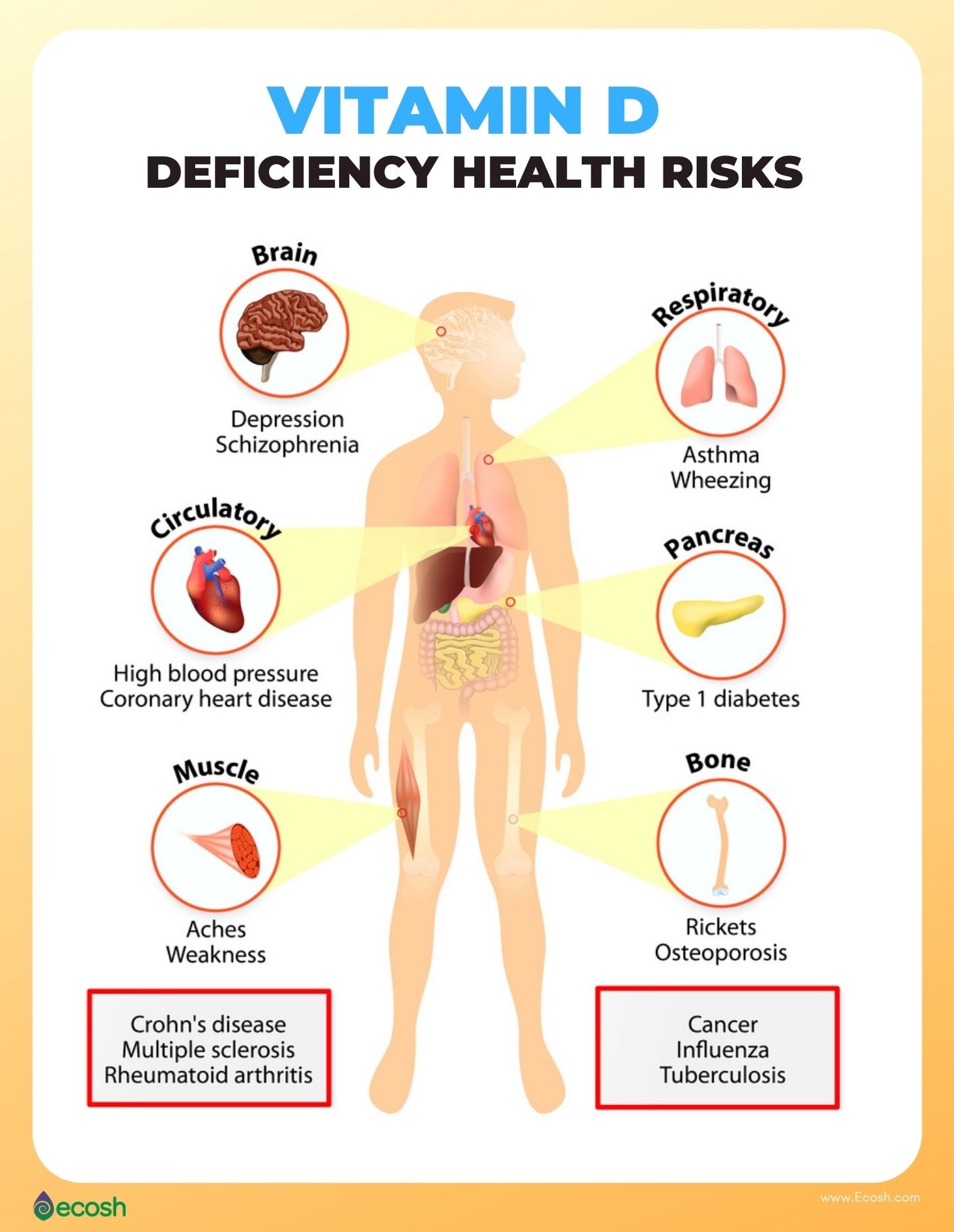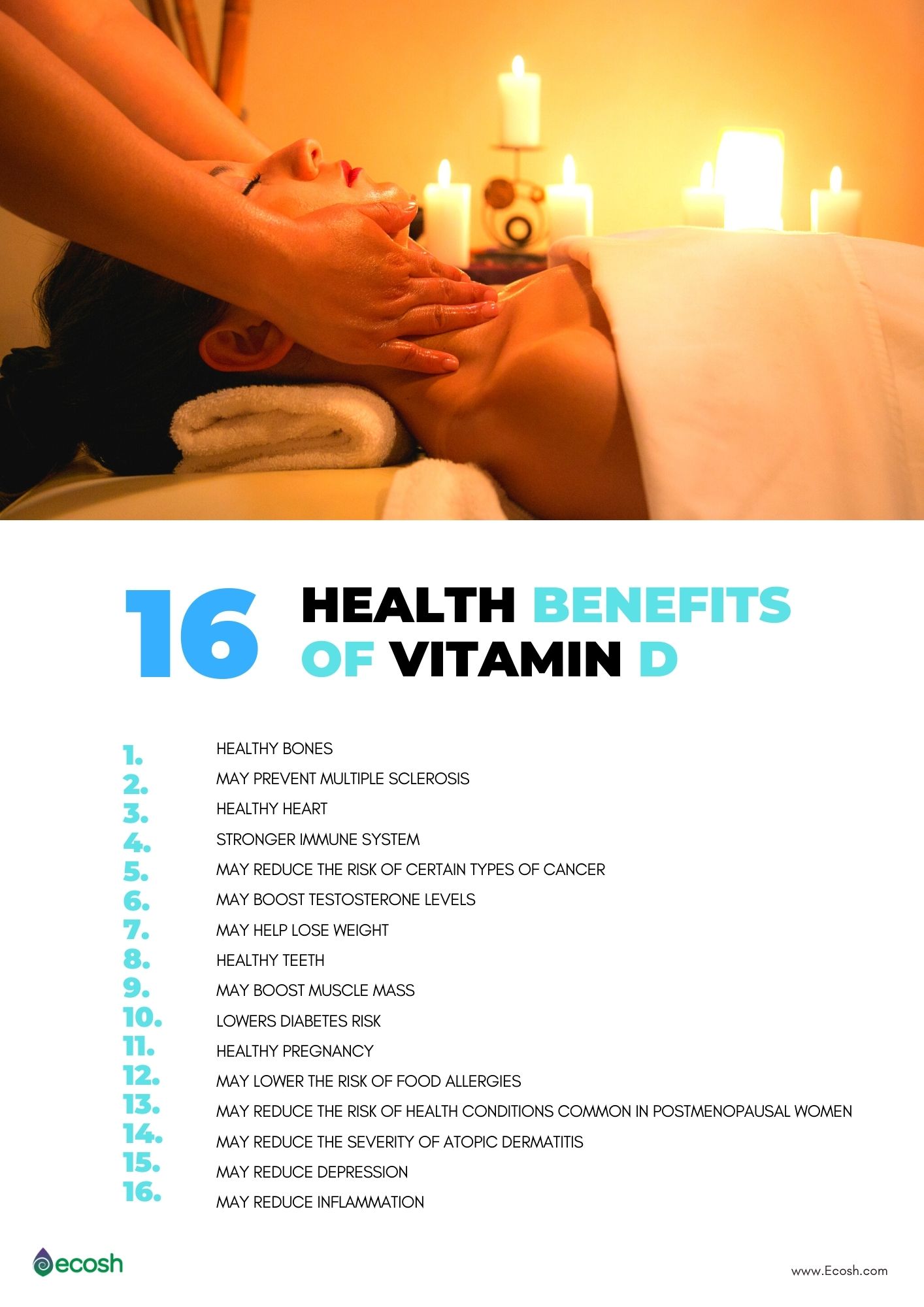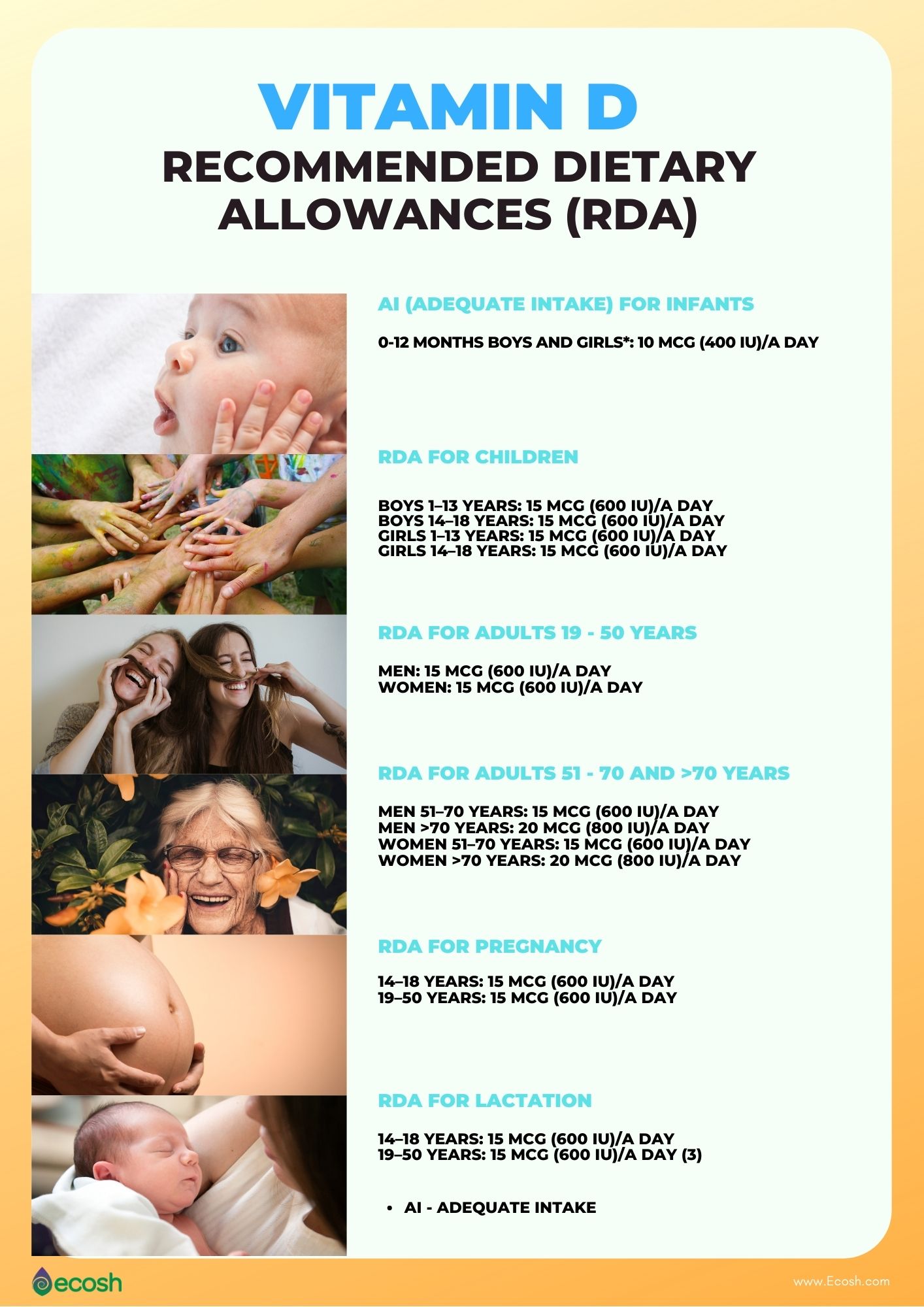Vitamin D has several health benefits and it’s easy to get it in sufficient amounts, as it’s free to all of us. However, even though, sun should give us enough vitamin D, about half of the world’s population suffer from vitamin D deficiency. Why is it like that and what are the amazing health benefits of vitamin D you should know about?
To clarify, although according to name, Vitamin D is a vitamin, it is actually a group of fat-soluble secosteroids responsible for many health benefits and biological effects in the body, as well as increasing intestinal absorption of phosphate, calcium, and magnesium.
Vitamin D3 (cholecalciferol) and vitamin D2 (ergocalciferol) are the most significant ones in this group. In fact, cholecalciferol is actually a highly versatile hormone in the body that is needed for several different processes in the body (1, 2).
 Source: National Institutes of Health (3).
Source: National Institutes of Health (3).
Vitamin D Production, Sources and Vitamin D Rich Foods
Vitamin D2 (ergocalciferol) is produced by invertebrates, some plants, and fungi, and the production is encouraged by ultraviolet light. D3 (cholecalciferol) is produced in the skin from 7-dehydrocholesterol by the sun (or ultraviolet light UV) with an UV index of 3 or more.
But, to maintain healthy vitamin D levels in your body, you should aim to get 10–30 minutes of midday sunlight, several times per week. In fact, people with darker skin may need even a little more than this (10, 11). However, as nowadays people stay and work more indoors, the vitamin D deficiency is very common.
Therefore, to obtain sufficient amounts of vitamin D you can eat more vitamin D rich foods or take vitamin D supplements, as low vitamin D levels might increase risks for some health conditions.
15 Vitamin D Rich Foods:
- Cod liver oil: 34.0 mcg (1,360 IU)/1 tbsp – 170% DV
- Trout (rainbow), farmed, cooked: 16.2 mcg (645 IU)/3oz – 81% DV
- Salmon (sockeye), cooked: 14.2 mcg (570 IU)/3 oz – 71% DV
- Mushrooms, white, raw, sliced, exposed to UV light: 9.2 mcg (366 IU)/ ½ cup – 46% DV
- Milk, 2% milkfat, vitamin D fortified: 2.9 mcg (120 IU)/1 cup – 15% DV
- Soy, almond, and oat milks, vitamin D fortified, various brands: 2.5-3.6 mcg (100-144 IU)/1 cup – 13-18% DV
- Ready-to-eat cereal, fortified with vitamin D: 2.0 mcg (80 IU)/1 serving – 10% DV
- Sardines (Atlantic), canned in oil, drained: 1.2 mcg (46 IU)/2 sardines – 6% DV
- Egg, scrambled**: 1.1 mcg (44 IU)/1 large – 6% DV
- Liver, beef, braised: 1.0 mcg (42 IU)/3 oz – 5% DV
- Tuna fish (light), canned in water, drained: 1.0 mcg (40 IU)/ 3 oz – 5% DV
- Cheese, cheddar: 0.3 mcg (12 IU)/1 oz – 2% DV
- Mushrooms, portabella, raw, diced: 0.1 mcg (4 IU)/½ cup – 1% DV
- Chicken breast, roasted: 0.1 mcg (4 IU)/3 oz 1% DV
- Beef, ground, 90% lean, broiled: 0 mcg (1.7 IU)/3 oz – 0% DV (3).
- mcg (μg) – Micrograms per serving
- IU – International Units per serving
- DV – Percent Daily Value
- oz – ounces
- ** Only egg yolk contains vitamin D
- 1 mcg (μg) of vitamin D is equivalent to 40 IU (9, 35).
Read more about vitamin D foods here.

Vitamin D Deficiency (VDD) Signs and Symptoms
For example, deficiency signs and symptoms might include:
- Bone pain and back pain
- Fatigue and tiredness
- Getting sick more often
- Muscle weakness
- Muscle aches, or muscle cramps
- Mood changes
- In addition, depression (4, 5).
Vitamin D Deficiency (VDD) Causes
Vitamin D deficiency is caused by a diet with inadequate vitamin D in conjunction with insufficient sun exposure (for example, reduced outdoor activities). About one billion people worldwide, across all ethnicities and age groups, have a vitamin D deficiency (VDD), and almost 50% people are vitamin D insufficient (10).
Therefore, vitamin D deficiency is a major health issue as hypovitaminosis D is an independent risk factor for total mortality (10).
For instance, some studies suggest that to prevent chronic disease – we may need even more vitamin D than currently recommended. However, dietary intake of vitamin D is limited, as only few foods contain vitamin D. Therefore, guidelines recommended supplementation at suggested daily intake and tolerable upper limit levels (10).

Vitamin D Deficiency (VDD) Risk Factors and Risk Groups
That is to say, the highest risk of vitamin D deficiency is for people who, for health or other reasons, do not exercise much outdoors without getting direct sunlight. Therefore, the biggest risk groups for vitamin D deficiency are people with a sedentary lifestyle, the elderly and people with reduced mobility. In fact, with age, the body’s ability to produce vitamin D decreases significantly.
- Infants and children under 5 years
- Pregnant and breastfeeding women
- Adults over 65 or when kidneys cannot convert vitamin D
- People who have limited exposure to sunshine like office workers
- People with darker skin
- Inflammatory bowel disease patients
- People with a high body fat percentage
- Vegans and vegetarians
- In addition, people with certain medical problems, including Crohn’s disease, cystic fibrosis, and celiac disease, as these conditions may affect your intestine’s ability to absorb vitamin D from the food
- In conclusion, people taking certain medications which can all impair vitamin D metabolism:

11 Vitamin D Deficiency (VDD) Health Risks
Vitamin D deficiency may lead to:
- Impaired bone mineralization, bone weakening and damage which leads to bone-softening diseases, including rickets in children (2).
- In addition, extreme rickets may cause skeletal deformities and pain, failure to thrive, hypocalcemic seizures, tetanic spasms, cardiomyopathy, dental abnormalities, and in addition, may lead to developmental delay (3).
- Osteomalacia in adults and adolescents, in which existing bone is incompletely or defectively mineralized during the remodeling process, resulting in weak bones. Signs and symptoms of osteomalacia are similar to those of rickets and include bone deformities and pain, hypocalcemic seizures, tetanic spasms, and dental abnormalities (3).
- Osteoporosis. For instance, getting enough calcium and vitamin D in childhood and teenage years may lower your risks of developing osteoporosis later in life (14).
- Cognitive impairment in older adults (6).
- Fall of the intestinal absorption of dietary calcium to 15%. For instance, normally (when not deficient in vitamin D) individuals usually absorb between 60-80% of calcium (2).
- Higher risk of death because of cardiovascular disease (6).
- Severe asthma in children (6).
- Some types of cancer. Most importantly, low vitamin D levels have also been associated with an increased risk of certain types of cancer (such as prostate cancer) (6, 7, 8, 18, 32).
- In addition, getting sick more often and catching viruses. Vitamin D is known to improve the work of immune cells, including T cells and macrophages, that protect your body against pathogens and viruses (15).
- In conclusion, oral diseases. Lack of vitamin D is also associated with oral diseases and has been linked with an increased risk of many oral problems such as caries, tooth defects, periodontitis and oral treatments failure (31).

Vitamin D 16 Health Benefits and Role in The Body
It is suggested that vitamin D could play a role in the prevention and treatment of a number of different conditions, such as (6).
1. Bones. Firstly, one of the Vitamin D health benefits is that together with calcium, optimal amounts of vitamin D may help support bone health, and prevent osteomalacia (softening of the bones due to a disorder of bone mineralization) and osteoporosis (thinning of the bone) ( 2, 16, 20, 21, 22, 23, 24).
2. Multiple sclerosis. Secondly, according to a 2006 study, vitamin Day may also play a role in multiple sclerosis development (3, 6, 17 , 18).
3. Heart. Thirdly, among other vitamin D health benefits, according to a 2008 study published on Circulation, adequate vitamin D levels may also decrease the chance of developing cardiovascular disease (17, 19).
4. Immune system and flu. In addition, according to 2010 research, vitamin D may help to reduce the risk of developing seasonal influenza A, as it is known that this vitamin may escalate the immune function (15, 17, 20).
5. Cancer. Moreover, as low vitamin D levels have also been associated with an increased risk of certain types of cancer (such as prostate cancer), than adequate levels of this vitamin may reduce the risk of these types of cancer (6, 7, 8, 18, 43, 44).
6. Testosterone levels. Vitamin D health benefits do not end here, as it is also important to men`s health and may increase testosterone levels. Although additional studies are still needed, recent research suggests that vitamin D deficiency may also lead to low testosterone levels.
Because low testosterone levels may cause a variety of health problems in men, such as sleep apnea, poor metabolism, low libido, and fatigue, maintaining adequate vitamin D levels is critical to men’s health (25, 26, 27).
7. Weight. For instance, in one study, people taking a daily calcium and vitamin D supplement were able to lose more weight than subjects taking a placebo supplement. Active vitamin D levels have also been associated with lean body mass (17, 29, 33).
8. Oral health and teeth. Vitamin D keeps bones, teeth and muscles healthy, as it helps to manage the levels of these vital nutrients like calcium and phosphate in the body. In addition, vitamin D may also help to lessen inflammation of gums which is associated with periodontal (gum) disease.
According to a 2020 review, the maintenance of appropriate vitamin D serum levels has been associated with better oral development and health throughout life. However, more research is still needed before starting any treatment (16, 30, 31).
9. Muscle mass. In addition, in 2017 study, researchers found that people who had a higher lean mass and muscle mass also had higher levels of active vitamin D. This suggests that active vitamin D may help to optimize muscle strength (33, 34).
10. Diabetes. May help to enhance the body’s sensitivity to insulin, and thus lessen the risk of insulin resistance, which is often an ancestor to type 2 diabetes.
Moreover, according to scientists, the daily vitamin D dose of more than 2000 IU is needed to keep an optimal level of vitamin D in the blood (>80 nmol/l), as at this level, the risk of diabetes has been found to be the lowest (3, 35, 36).
11. Pregnancy. Researchers suggest that pregnant women who are deficient in vitamin D may have a higher risk of developing preeclampsia and giving birth preterm. In addition, among pregnant women, poor vitamin D status is also associated with gestational diabetes and bacterial vaginosis.
However, pregnant women should be careful with taking too much vitamin D, as in a 2013 study, researchers associated high vitamin D levels during pregnancy with an increased risk of food allergy in the child during the first 2 years of life (37, 38, 39).
12. Food allergies. As food allergies in the population have increased, vitamin D levels appear to have concurrently decreased. Moreover, up to 10 percent of 12-month-old infants have a clinically confirmed food allergy. Therefore, inadequate vitamin D levels have been linked with childhood food allergies (37, 40, 41).
13. Steroid-resistant asthma and atopic dermatitis. It is found that vitamin D may improve the antiinflammatory actions and may probably find use as therapy secondary in steroid-resistant asthma. In addition, recent data suggest that vitamin D supplementation may also reduce the severity of atopic dermatitis (37, 41).
14. Post menopause. In fact, postmenopausal women have a notably higher prevalence of osteoporosis, breast cancer, and cardiovascular disease.
However, current scientific evidence suggests that in addition to calcium homeostasis, vitamin D may have protective properties against breast neoplasms, it may lower the risk of cardiovascular diseases and promote bone health (42, 43).
15. Depression. In addition, vitamin D is involved in various brain processes, and vitamin D receptors are present on neurons in areas of the brain thought to be involved in the pathophysiology of depression (3).
16. Inflammation. In conclusion, vitamin D might affect the inflammatory microenvironment. Even more, scientists suggest that there might be a close relationship between inflammation and cancer (44).
However, do not start to self medicate and consult your doctor or health care provider before diagnosing your disease, changing your current medication or taking any supplement for the treatment of any health condition as researchers have still not found consensus and clinical trials have not confirmed all these health benefits (3).

Recommended Dietary Allowances (RDAs) for Vitamin D
As the correct level of vitamin D varies from person to person, the only way to be sure that your vitamin D levels are where they should be is to request a 25-hydroxyvitamin D, or 25(OH)D, blood test from your GP (the perfect blood level of 25 OH D should be 60ng/ml) (3).
RDA (Recommended Dietary Allowances) for Children
- 0-12 months boys and girls (adequate Intake (AI)): 10 mcg (400 IU)/a day
- Boys 1–13 years: 15 mcg (600 IU)/a day
- Boys 14–18 years: 15 mcg (600 IU)/a day
- Girls 1–13 years: 15 mcg (600 IU)/a day
- Girls 14–18 years: 15 mcg (600 IU)/a day
RDA (Recommended Dietary Allowances) for Adults 19 – 50 Years
- Men: 15 mcg (600 IU)/a day
- Women: 15 mcg (600 IU)/a day
RDA (Recommended Dietary Allowances) for Adults 51 – 70 and >70 Years
- Men 51–70 years: 15 mcg (600 IU)/a day
- Men >70 years: 20 mcg (800 IU)/a day
- Women 51–70 years: 15 mcg (600 IU)/a day
- Women >70 years: 20 mcg (800 IU)/a day
RDA (Recommended Dietary Allowances) for Pregnancy
- 14–18 years: 15 mcg (600 IU)/a day
- 19–50 years: 15 mcg (600 IU)/a day
RDA (Recommended Dietary Allowances) for Lactation
- 14–18 years: 15 mcg (600 IU)/a day (3).

Important to Know
- Firstly, vitamin D is a fat soluble vitamin. Therefore it will absorb best in your bloodstream when taken together with high-fat foods.
- Secondly, the use of sunscreen prevents the synthesis of vitamin D in the skin.
- Thirdly, without sunscreen in the sun, the skin only produces vitamin D in the first 15-20 minutes.
- Moreover, 50% of the human population worldwide suffer from vitamin D3 deficiency.
- IU (International Unit) – The amount of a substance that has a certain biological effect
- mcg (microgram) or µg (microgram)
- 1 mcg (or µg) = 40 IU
Health Risks from Excessive Vitamin D
- Firstly, excess amounts of vitamin D are toxic and this may result in marked hypercalcemia.
- Secondly, hypercalcemia may cause nausea, vomiting, muscle weakness, neuropsychiatric disturbances, pain, loss of appetite, dehydration, polyuria, excessive thirst, and kidney stones.
- In addition, in extreme cases, vitamin D toxicity may cause renal failure, calcification of soft tissues throughout the body (including in coronary vessels and heart valves), cardiac arrhythmias, and even death (3).
However, these signs and symptoms of toxicity are unlikely at daily intakes below 250 mcg (10,000 IU) (3).
For instance, the Institute of Medicine, Food and Nutrition Board (FNB) has noted that vitamin D intakes lower than the ULs might have adverse health effects over time. Therefore, they have recommended to avoid serum 25(OH)D levels above approximately 125–150 nmol/L (50–60 ng/mL) (3).
Moreover, even lower serum levels (approximately 75–120 nmol/L [30–48 ng/mL]) are associated with increases in rates of all-cause mortality, risk of cancer at some sites (e.g., pancreas), risk of cardiovascular events, and number of falls and fractures among older adults (3).
NB! The information provided here is for informational purposes only, so do not consider it as health care or medical diagnosis and treatment. Do not consider this information as a guarantee of the results you want to achieve. In addition, this information here is not intended to replace the advice of your physician or other healthcare professional.
Even more, you should not use it to diagnose or treat a health problem. Before changing or discontinuing your existing medication, treatment, or care, or taking any dietary supplements, be sure to consult with your healthcare professional or doctor before starting any diet or program, or if you suspect you may have a medical condition.
Compiled by Maria-Helena Loik
Pictures: Pexels.com, Pixabay.com, Shutterstock.com
Sources:
- https://www.ncbi.nlm.nih.gov/pmc/articles/PMC1240026/
- https://en.wikipedia.org/wiki/Vitamin_D
- https://ods.od.nih.gov/factsheets/VitaminD-HealthProfessional/
- https://my.clevelandclinic.org/health/articles/15050-vitamin-d–vitamin-d-deficiency
- https://www.healthline.com/nutrition/vitamin-d-deficiency-symptoms#TOC_TITLE_HDR_3
- https://www.webmd.com/diet/guide/vitamin-d-deficiency#1
- https://www.everydayhealth.com/news/illnesses-linked-vitamin-d-deficiency/#:~:text=Prostate%20Cancer%20and%20Low%20Vitamin,American%20and%20African%20American%20men.
- https://www.ncbi.nlm.nih.gov/pmc/articles/PMC1470481/
- https://health.gov/our-work/food-nutrition/2015-2020-dietary-guidelines/guidelines/appendix-12/
- https://www.ncbi.nlm.nih.gov/pmc/articles/PMC3356951/#:~:text=Vitamin%20D3%20(cholecalciferol)%20is,scientifically%20known%20as%2022%2Ddihydroergocalciferol.
- https://www.healthline.com/nutrition/vitamin-d-from-sun#dangers
- https://www.prevention.com/health/a20488821/risk-for-vitamin-d-deficiency/
- https://www.guidelinesinpractice.co.uk/nutrition/vitamin-d-deficiency-people-at-risk-need-access-to-supplements/352598.article#:~:text=Profound%20vitamin%20D%20deficiency%20is%20particularly%20common%20among%3A%20infants%20and,and%20people%20with%20darker%20skin.
- https://www.webmd.com/osteoporosis/guide/osteoporosis-questions-answers#1
- https://www.healthline.com/nutrition/vitamin-d-coronavirus
- https://www.nhs.uk/conditions/vitamins-and-minerals/vitamin-d/#:~:text=Vitamin%20D%20helps%20regulate%20the,condition%20called%20osteomalacia%20in%20adults.
- https://www.healthline.com/health/food-nutrition/benefits-vitamin-d#fights-disease
- https://www.ncbi.nlm.nih.gov/pmc/articles/PMC1470481/
- https://pubmed.ncbi.nlm.nih.gov/20219962/
- https://www.ncbi.nlm.nih.gov/pmc/articles/PMC3221132/
- https://www.ncbi.nlm.nih.gov/pmc/articles/PMC2621390/
- https://pubmed.ncbi.nlm.nih.gov/31454046/
- https://www.uptodate.com/contents/treatment-of-osteoporosis-in-men?topicRef=2023&source=see_link
- https://medlineplus.gov/ency/article/000376.htm#:~:text=Osteomalacia%20is%20softening%20of%20the,the%20condition%20is%20called%20rickets.
- https://takecareof.com/articles/best-vitamins-supplements-for-men
- https://pubmed.ncbi.nlm.nih.gov/21154195/
- https://www.mensjournal.com/food-drink/supplements-every-guy-needs/
- https://academic.oup.com/ajcn/article/89/5/1321/4596773
- https://www.cambridge.org/core/journals/british-journal-of-nutrition/article/calcium-plus-vitamin-d-supplementation-and-fat-mass-loss-in-female-very-lowcalcium-consumers-potential-link-with-a-calciumspecific-appetite-control/623D71E0A965E910C48903089FA7B56C
- https://www.dhsv.org.au/dental-health/teeth-tips-and-facts/calcium-vitamin-d-and-phosphorus#:~:text=Vitamin%20D%20regulates%20the%20body%27s,is%20essential%20for%20healthy%20teeth.
- https://www.ncbi.nlm.nih.gov/pmc/articles/PMC7285165/
- https://lpi.oregonstate.edu/mic/vitamins/vitamin-D#cancer-prevention
- https://www.medicalnewstoday.com/articles/315863#Supplemental-vitamin-D-may-enhance-muscle-function
- https://journals.plos.org/plosone/article?id=10.1371/journal.pone.0170665
- https://www.diabetes.co.uk/food/vitamin-d.html#:~:text=Effects%20on%20diabetes,precursor%20to%20type%202%20diabetes.
- https://www.news-medical.net/health/Vitamin-D-and-Type-2-Diabetes.aspx
- https://www.medicalnewstoday.com/articles/161618#deficiency
- https://pubmed.ncbi.nlm.nih.gov/31411387/
- https://www.ncbi.nlm.nih.gov/pubmed/23253182
- https://www.aaaai.org/conditions-and-treatments/library/allergy-library/vitamin-d-food-allergy
- https://pubmed.ncbi.nlm.nih.gov/25985947/
- https://www.npjournal.org/article/S1555-4155(14)00423-1/pdf#:~:text=Current%20scientific%20evidence%20suggests%20that,with%20breast%20cancer%20and%20CVD.
- https://www.health.harvard.edu/staying-healthy/time-for-more-vitamin-d
- https://www.ncbi.nlm.nih.gov/pmc/articles/PMC6164284/#:~:text=Inflammation%20is%20causally%20related%20to,of%20many%20immune%2Drelated%20diseases.


